North Hants Golf Club returning to former glories
 At about the same time as The Beatles were writing and recording the music for their first feature film, A Hard Days Night, I was a young lad looking to finance my record buying.
At about the same time as The Beatles were writing and recording the music for their first feature film, A Hard Days Night, I was a young lad looking to finance my record buying.
One of the ways I would do this was to cycle the four miles from home to North Hants Golf Club, wade across a little stream and search for golf balls in the rough. These were then turned into hard cash by selling them to a golfing neighbour - thrupence for good ones and a penny for average ones!
So, it was good to return to my old childhood haunt - just forty-seven years later - to meet up with Course Manager, Mark Openshaw.
On the surface, apart from a thoroughly modern clubhouse and a sprawl of contemporary houses where once there was heathland, little appeared to have changed but, as I was to discover, nothing could be further from the truth.
Mark Openshaw is undecided whether North Hants is a heathland or parkland course, as it shares the attributes and ecology of both. Either way, he is superbly qualified to tend the course, having begun his career on the similar terrain of St George's Hill and Wentworth, before rising through the ranks at Sunningdale, under the wing of 'Big' Jack McMillan, to become deputy course manager.
"I spent twenty happy years at Sunningdale, and have benefitted from working under many good Course Managers, such as Jack McMillan, Brian Turner and Murray Long. Jack and Brian, in particular, having a massive influence on the way I think about greenkeeping," says Mark. "But, the time was right to move on and I needed a new challenge so, when the Course Manager position here became available, I applied." That was five years ago.
 North Hants is surrounded, on all sides, by modern life. When it was founded in 1904, it was sculpted out of the native heathland close to the small town of Fleet in north Hampshire. Now, it is bordered, on its south side, by the M3, on the north by the mainline to Waterloo, west the town of Fleet and, more recently, on its east side, by a large housing estate.
North Hants is surrounded, on all sides, by modern life. When it was founded in 1904, it was sculpted out of the native heathland close to the small town of Fleet in north Hampshire. Now, it is bordered, on its south side, by the M3, on the north by the mainline to Waterloo, west the town of Fleet and, more recently, on its east side, by a large housing estate.
By modern standards the course is relatively short at 6,450 yards par 70, and now acts as a green oasis amongst the urban sprawl. It is surprisingly peaceful, considering its position.
Mark confesses to being horrified by the condition of the course when he arrived, and was presented with heavily compacted fairways, huge areas of dead grass, inconsistent greens, and worn out tees, with trees smothering the life out of the course. "It had been overfed, overwatered and there was no root structure, anywhere! And, I had, in the main, a workforce that weren't motivated."
Two survivors from the old regime are first assistant, Rob Schofield and Martyn Shacklock, who have worked on the course for nineteen and eight years respectively. "I 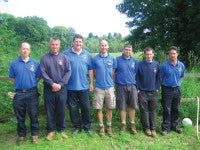 identified that, with the right training and the necessary enthusiasm, they could help me achieve my goals, but the rest have gone!" says Mark in a matter of fact way.
identified that, with the right training and the necessary enthusiasm, they could help me achieve my goals, but the rest have gone!" says Mark in a matter of fact way.
The other members of the team are Mark's deputy, Andy Reason, who joined soon after Mark; Martin Shacklock, who is the spraying and grinding expert; Kyle Adams, and recent recruits, Dan Partridge from Wentworth and Andy Hallett from nearby Hartley Wintney Golf Club. "We now have an excellent team of greenkeepers who work very hard and to a good standard," says Mark.
Equally poor was the machinery situation. "At my interview, I hadn't investigated the contents of the shed, assuming that much of it was 'out on the course' during my visit. So, I was surprised to learn that the team were working with the bare minimum."
Investment had not been an issue at North Hants even before Mark's arrival. The new clubhouse cost a pretty penny, and £100,000 had been spent on new workshop and mess facilities for the greenkeepers. So, there seemed to be two main priorities - get some air onto and into the course and upgrade the machinery.
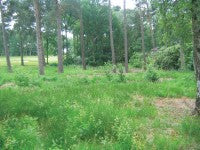 The first was achieved by calling in a specialist contractor to remove fifty percent of the trees from the course. This was completed over two winters. "The results have been fantastic," enthuses Mark. "The members were not too happy whilst the work was being carried out, but they have all come round now that they can see the benefits to the playing surfaces."
The first was achieved by calling in a specialist contractor to remove fifty percent of the trees from the course. This was completed over two winters. "The results have been fantastic," enthuses Mark. "The members were not too happy whilst the work was being carried out, but they have all come round now that they can see the benefits to the playing surfaces."
"The course is now much more open and we have seen a huge increase in the variety of flowers and other wildlife around the course. Heather is returning naturally to places it hasn't grown in decades, which is very encouraging. Some of the older heather does need managing, and this is something we will address soon."
One of Mark's bugbears is the rhododendrons that grow around the course. Whilst they are an invasive species, and serve no benefit to native wildlife, the members love the splash of colour they provide, so removing them is unlikely to happen, says Mark. As I take a photo of one of the offending plants by the lake - they do look very pretty - a family of coots wander out of the water to greet me. "They think you are going to feed them," says Mark. "One of our lady members feeds them every day, so anyone who stands by the edge gets a greeting from them."
a family of coots wander out of the water to greet me. "They think you are going to feed them," says Mark. "One of our lady members feeds them every day, so anyone who stands by the edge gets a greeting from them."
With the course now benefitting from better airflow, Mark has been able to tackle all the other problems out on the course. £150,000 has been spent on new machinery - most of it Toro - to help him achieve this, along with a Rainbird irrigation system to the fairways, which was installed by M J Abbotts. "We are also putting in a reservoir over the next year or so, too," confirms Mark.
"The underlying soil is typical heathland, sandy and free draining, so getting a decent root structure was important. To achieve this we have carried out extensive aeration programmes on all playing surfaces. For the fairways we call on the services of ALS to do hollow core and collect, they are quick and efficient and do a great job - in and out in a couple of days. We also had them apply Lebanon 30:0:0 this year, the results have been really good and it's great to see the course with plenty of definition and healthy looking fairways. To my knowledge, it's the first time the fairways have ever been treated."
"To give you some idea of how bad things were, when using the Wiedenmann on the greens and tees, the top three or four inches would just peel off. There was 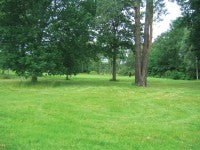 simply nothing holding them together," he bemoans.
simply nothing holding them together," he bemoans.
Mark calls on agronomist David Stansfield for advice and, at his suggestion, eight of the greens were given the Ecosol Drill 'n' Fill treatment.
"Sixteen of our greens are soil push up, whilst two, the 2nd and 3rd, are a sand construction. I wouldn't call them USGA though, it's more like a silty mud!" says Mark. "They cause me no end of problems, but I'm slowly getting to grips with them. We have put the Dryject across them using material supplied by Ecosol." I offer that they don't stand out as looking any different to the other greens, to which Mark replies, "yes, but I know!"
As we drive around the course, Mark, as well as chuntering about the performance of his golf buggy - hardly surprising, as it is transporting two eighteen stone plus men - points out areas of particular interest. We stop by an area of thinned out trees which are now home to campions, foxgloves, herb robert and other flowers I don't immediately recognise. "Five years ago, the trees came right up to the fairway. Now, I have been able to introduce areas of semi rough, rough and, as I call it, jungle. The members aren't keen on 'the jungle', but I'll win them round," he says, with a smile.

By improving root growth and, therefore, grass cover, Mark has been able to add definition to the course. Fairways have been narrowed to accommodate areas of rough and semi rough, whilst thirty of the sixty bunkers have been reshaped, enlarged and, in some cases, moved to become proper hazards again.
"The bunker work has been done in-house, with the exception of the 15th (four bunkers)," explains Mark. "In some instances, they were so out of position as to serve no purpose at all. It's been a job we have carried out over recent winters and, visually, they look great. It was a bit of trial and error to start with," says Mark. "We had completed one bunker that just didn't look right to the eye. So, one of the team suggested changing the front to make it more 'curvy'. That did the trick. Another one 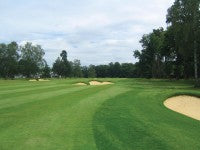 had such a steep entrance that anyone of advancing years who went in would have needed a sherpa to get back out of it!"
had such a steep entrance that anyone of advancing years who went in would have needed a sherpa to get back out of it!"
With the greens now performing consistently across all eighteen, I ask Mark about stimp readings and cutting heights. "I'm not a huge fan of the stimp," he says, but then goes on to tell me that they cut at between 2.5mm and 3mm in the summer, with an average stimp reading of around 9.5 to 10.5, and 3.5mm to 4.5mm in the winter. "We hold the Hampshire Hog tournament here every year. It's one of the top ranking amateur events in the country," he explains. "For that, we do tweak the speed. The fastest we have achieved is a stimp reading of 13."
Tees are kept at around 8-10mm throughout the year, and the fairways between 13-16mm. Semi rough is cut once a week to 44mm and the rough is kept at four to five inches. The jungle is flail mown once a year.
Mark started studying for a degree in sports turf science online through Myerscough College. "I've done seven modules so far and hope to finish it over the next couple of years. It's hard work and very time consuming, but will be worth it in the end. Hopefully, by the end of 2013, I will also have gained my Master Greenkeeper Certificate."

As a member of both trade associations - he is a huge fan of their training programmes - Mark is keen to put all his staff through the relevant qualifications. "We will, hopefully, have a staff of eight by the end of 2013 who will have started or gained NVQ Level 3 and will all have their spraying qualification."
Our final stop is a visit to the stream I used to hop across as a kid. It now runs alongside the practice area, which is next on Mark's list to get an upgrade.
As we head back to the shed, along a now lush fairway, Mark stops to allow an elderly member to play his next shot. Once he has successfully hit the green, he turns to Mark and says; "can I just say how excellent the course is looking. It's a credit to you."
What's in the shed?
 Toro 3250-D Greensmasters x 3
Toro 3250-D Greensmasters x 3
Toro GM100 pedestrian greensmowers x 5
Toro GM1600 pedestrian tees mowers x 3
Toro Workman 4300 spraying vehicle
Toro Workman 2000 sprayer vehicle
Toro Workman MDX utility vehicles x 2
Toro Workman 1110 utility vehicle
Kawasaki Mule utility vehicles x 2
Cushman Turf Truck utility vehicle
Toro Procore 648 aerator
Toro 6500-D fairway mowers x 2
Toro 3500-D semi rough mower
Kioti DK50C tractor
Kioti DK55 tractor
Cas 4210 tractor
Kubota STV40A compact tractor
John deere 1600 rough cutter
Kubota mini digger
BLEC seeder
GreenTek slitter/aerator
Johnn Deere Aercore
Wiedenmann Terraspike
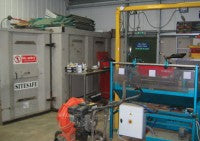 Ryan turfcutter
Ryan turfcutter
Belle Group Waca Plate
Trilo SG400 sweeper
Sisis Auto Rotarake
Turf Boss Greens Iron
Tru Turf Roller
GreenTek greens brush
Toro Transpro 1000 greensmower trailers x 2
Toro Transpro 800 greensmower trailers x 6
Tycrop dresser
GreenTek utility trailers x 2
Tornado blower
Stuil pressure washer
Kawasaki brushcutters x 6
Flymo hover mowers x 3
Husqvarna 136 chainsaw
Stihl MS441 chainsaw
Stihl BT121 post hole borer
Hayter Harrier rotary mower
Hunter Grinder
Various GreenTek attachments
